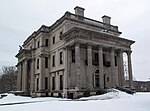George Rymph House

The George Rymph House is a historic house located on Albany Post Road (U.S. Route 9) in Hyde Park, New York, United States. It is a stone house built during the 1760s by a recent German immigrant. In 1993, it was listed on the National Register of Historic Places.It is one of the few remaining pre-Revolutionary houses in Hyde Park, the oldest stone house, and second-oldest house overall in the town. The Rymph family retained ownership of the house until selling it in the early 20th century to the Dominican Fathers who owned most of the surrounding property at the time. Several renovations, including a stucco exterior, have modified the original appearance.It served as a cottage for the camp's caretaker until the early 21st century, when the land conservation organization Scenic Hudson bought the property. The house has been vacant since then. Scenic Hudson has been trying to sell or lease the house to a party interested in restoring and preserving it.
Excerpt from the Wikipedia article George Rymph House (License: CC BY-SA 3.0, Authors, Images).George Rymph House
Albany Post Road,
Geographical coordinates (GPS) Address Nearby Places Show on map
Geographical coordinates (GPS)
| Latitude | Longitude |
|---|---|
| N 41.8225 ° | E -73.935833333333 ° |
Address
Albany Post Road 4837
12538
New York, United States
Open on Google Maps






